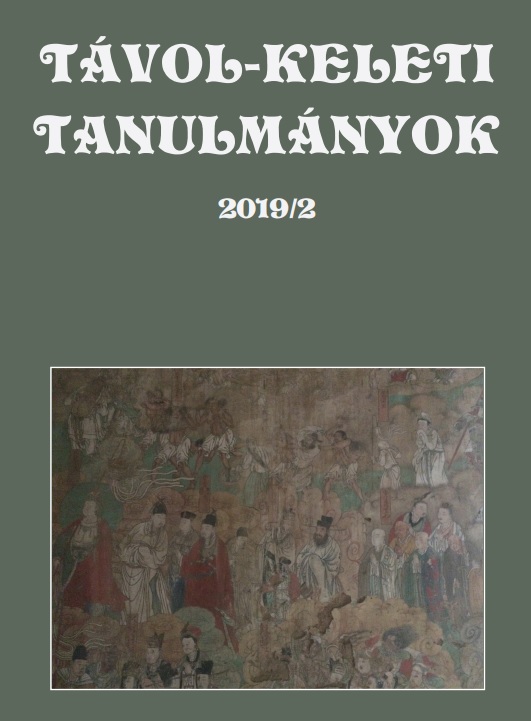Published 2020-10-30
Keywords
- Lajos Ligeti,
- Khitan Studies,
- numerals,
- Hungarian Academy of Sciences,
- Khitan language
How to Cite
Copyright (c) 2020 the author(s)

This work is licensed under a Creative Commons Attribution-NonCommercial 4.0 International License.
Abstract
The late Professor Louis Ligeti was one of the most influential scholars of the 20th century in the fields of Altaic historical linguistics and many others. Ligeti’s personal scholarly notes, according to the provisions of his will, were deposited in the Library of the Hungarian Academy of Sciences (HAS) and were not released for 40 years. In 2018 a special research team of the HAS of Linguistics and Literary Scholarship Section was established to process the contents of the more than 70 large cardboard boxes. This study introduces a segment of his notes on deciphering the Khitan language, dealing with numerals, and offers insights into the current opinion of scholars whenever it varies from Ligeti’s. Minor corrections to the readings of Khitan ‘one’ as well as to the name of the ‘Old(er) Khitan State’ are also suggested.
References
- Liaoshi遼史 facsimile: https://ctext.org/library.pl?if=en&file=80017.
- MTAK Kézirattár Ligeti Lajos hagyaték 1/2(4); 5/4(4); 5/3(4).
- Qidan guo zhi 契丹國志 facsimile https://ctext.org/library.pl?if=en&file=104543.
- Shuofu/Liao zhi fejezet 說郛遼志 facsimile: https://ctext.org/library.pl?if=en&file=81665.
- Apatóczky, Ákos Bertalan – Róna-Tas, András 2019. „A new comprehensive monograph on Khitan” (review article). Acta Orientalia Academiae Scientiarum Hungaricae 72/2: 259–268. https://doi.org/10.1556/062.2019.72.2.7
- Chinggeltei (Qingge’ertai 清格尔泰) et al. 1985. Qidan xiaozi yanjiu 契丹小字研究 [Research on the Khitan Small Script]. Beijing: Zhongguo shehui kexue chubanshe.
- Chinggeltei (Qingge’ertai 清格尔泰) 2002. Qidan xiaozi shidu wenti 契丹小字釋讀問題 [Problems of the interpretation of the Kitan small script]. Tokyo: Research Institute for Languages and Cultures of Asia and Africa, Tokyo University of Foreign Studies.
- Chinggeltei (Qingge’ertai 清格尔泰) 1997. „Qidanyu shuci ji qidan xiaozipin dufa” 契丹语数词及契丹小字拼读法 [The Khitan numerals and the reading of the Khitan Small Script graphic combinations].” Nei Menggu daxue xuebao (Zhexue shehui kexueban) 内蒙古大学学报 (哲学社会科学版) 4: 1–9.
- CWJ = Chinggeltei – Wu Yingzhe – Jiruhe 2017. Qidan xiaozi zai yanjiu 契丹小字再研究 [Further Research on Khitan Small Script]. Vols. I–III. Beijing.
- Hölzl, Andreas 2017. „New evidence on Para-Mongolic numerals”. Suomalais-Ugrilaisen Seuran Aikakauskirja/Journal de la Société Finno-Ougrienne 96: 97–113. https://doi.org/10.33340/susa.70222
- Ishida, Mikinosuke 1934. „De vocabulario sinico-mongolico. Chih-yuan i-yu. 至元譯語 composita (sic!) circa Saeculum XIII.” Tōyōgaku sōhen (Philologia Orientalis) 1: 1–26.
- Janhunen, Juha (ed.) 2003. The Mongolic languages. London: Routledge.
- Ji Shi 即实 [= Batu]1986. „Guanyu Qidan shuci yindu wenti 关于契丹数词音读问题 [On the reading problems of the Khitan numerals].” Neimenggu daxue xuebao 1986/4: 89–100.
- Ji Shi 即实 [= Batu]2012. Mitian gengyun: Qidan xiaozi jiedu xu 谜田耕耘 : 契丹小字解读续 [Thorough processing of a riddle – continuing the decipherment of Khitan Small Script]. Shenyang.
- Kane, Daniel 2009. The Kitan Language and Script. Brill: Leiden-Boston. https://doi.org/10.1163/ej.9789004168299.i-306
- Kara, György [= Qaradorǰi] 1997. „Kitan kelen-ü toγan-u neres [Numerals in Khitan].” In: Lunwen yu jinianwen, jininan Qingge’ertai jiaoshou congjiao 50 zhou nian wenji. Neimenggu daxue, 225–227.
- Kara, György 2005. Books of the Mongolian Nomads: More Than Eight Centuries of Writing Mongolian. Bloomington: Indiana University, Research Institute for Inner Asian Studies.
- Ko, Seongyeon 2013. „The end of the Korean Vowel Shift controversy”. Korean Linguistics 15.2: 199–221. https://doi.org/10.1075/kl.15.2.02ko
- Ko, Seongyeon 2011. „Vowel contrast and vowel harmony shift in the Mongolic languages”. Language Research 47/1: 23–43. https://doi.org/10.1002/9781444335262.wbctp0123
- Ligeti Lajos 1927. „A kitaj nép és nyelv.” Magyar Nyelv 23: 293–310.
- Ligeti Lajos 1986. A magyar nyelv török kapcsolatai a honfoglalás előtt és az Árpád-korban. Budapest: Akadémiai Kiadó.
- Róna-Tas, András 2016a. „Remarks on the ethnonym Khitan.” Turkic languages 20: 157–169.
- Róna-Tas, András 2016b. „Khitan studies I. The graphs of the Khitan small script. 1. General remarks, dotted graphs, numerals.” Acta Orientalia Academiae Scientiarum Hungaricae 69/2: 117–138. https://doi.org/10.1556/062.2016.69.2.1
- Róna-Tas, András 2019. „Egy ismeretlen írás és nyelv megfejtése: a kitan.” Magyar Tudomány 2019/12: 1846–1856. https://doi.org/10.1556/2065.180.2019.12.10
- Shimunek, Andrew 2018. „Early Serbi-Mongolic – Tungusic lexical contact: Jurchen numerals from the 室韋 Shirwi (Shih-wei) in North China.” In: Ákos Bertalan Apatóczky – Christopher P. Atwood (eds.): Philology of the Grasslands. Essays in Mongolic, Turkic, and Tungusic Studies. Brill, Languages of Asia 17, 331–346. https://doi.org/10.1163/9789004351981_019
- Shimunek, Andrew 2017. Languages of Ancient Southern Mongolia and North China. Wiesbaden: Harrassowitz. https://doi.org/10.2307/j.ctvckq4f7
- Stein, Rolf 1939. „Leao-tche (遼志)”. T'oung Pao, Second Series, Vol. 35, 1/3: 1–154. https://doi.org/10.1163/156853239X00017
- Vovin, Alexander 2017. „Koreanic Loanwords in Khitan and Their Importance in the Decipherment of the Latter.” Acta Orientalia Academiae Scientiarum Hungaricae 70/2 (Special issue on the Khitan Studies ed. by Ákos Bertalan Apatóczky): 207–215. https://doi.org/10.1556/062.2017.70.2.4

